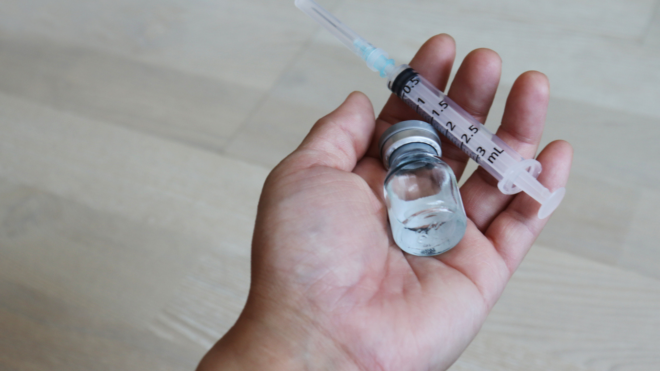
Skin cancer should be a concern for everyone. According to the Skin Cancer Foundation, it's the most common form of cancer in America, and 20% of Americans will develop skin cancer by the time they're 70 years old. While folks who don't burn as easily aren't as much at risk as the more fair-skinned among us, nobody is as safe from skin cancer as they tend to think. And the truth is, having had even just a handful of sunburns in our life — five or more — can increase our risk for developing melanoma twice over. Here's the good news, though: If we know what we should be looking for, we can be proactive, preventive, and safe. Once we know what to look for, we can go to the dermatologist as soon as when we see something that looks like it may be problematic. But knowing what to look for is the critical first step.
And there's good news here, too. Actually, given that we're talking about cancer, which usually feels pretty bleak, we're going to go ahead and call this great news: When skin cancer is detected at an early stage, it's arguably the easiest cancer to treat, and has a five-year survival rate of 99%. Yep, that means 99% of the people who develop melanoma that's detected and treated early on are OK afterwards. So it's really worth knowing what to look for, right? In more good news around cancer treatments, check out some major advances in cancer treatment in the last two decades. It's inspiring to us how far medical science has come, and how much better treatments have gotten in recent years. For anyone who's concerned they may have skin cancer and who wants to know what that looks like from the patient's perspective, read about a mom who documented her skin cancer recovery online. And to lower the risk for us and our families, read on here, and consider understanding why sunscreen isn't enough protection and how to protect a baby from the sun.
Watch for Any Changes

Believe it or not, skin cancer doesn't always start as a mole or freckle. "Although it's important to look for irregular-looking dark brown or black moles, skin cancer can come in all sizes, shapes and colors," says Dr. Elizabeth Tanzi, co-director of the Washington Institute of Dermatologic Laser Surgery in Washington, D.C. "So, any skin lesion that is changing in size, shape or color, or if it itches or bleeds, it needs evaluation by a dermatologist."
Heed the 'Ugly Duckling' Rule

For those of us who are covered in spots and freckles, we may feel as if we have no idea what to look for when it comes to irregularity. If this hit close to home, remember the "ugly duckling" rule. "In a person with several moles, is there one that doesn't look like it belongs?" says Beverly Hills surgical oncologist Dr. Travis Kidner, who specializes in the care of melanoma patients and is a melanoma survivor himself. "Does one stand out from all the others either by size, shape, color? These 'ugly duckling' lesions should be brought to the attention of a dermatologist."
Once a Month Self-Checks

Doing self-checks for skin cancer should be part of our regular health care routine — like breast cancer checks. "Either before or after the shower, and ideally once a month," says Tanzi. "By doing it frequently, it is easier to tell if something has changed."
Enlist a Partner

It's easy to see the front half of the body, but let's face it: There's a lot of skin we can't easily catch sight of. "Many of the melanomas on my patients were discovered by their significant other," Kidner says. "My mentor always advised his patients to get their significant others completely naked once a month and to map out and monitor any moles or skin lesions that had changes in their appearance."
Look At: Asymmetry

When we're looking for changes or abnormalities in our skin, remember the A, B, C, D, E's, says Kidner. "'A' stands for 'asymmetrical,'" he says. "Does the mole have an irregular shape with two parts that look very different?"
Look At: Borders

Kidner says that, next, the "B" stands for "border." Trace the outline of the mole or freckle. "Is the border irregular or jagged?" asks Kidner. If so, call a derm — it's time to get it checked out before it gets worse.
Look At: Color

"C" is for 'color.' "Is the color uneven?" asks Kidner. Most normal moles and spots are the same color — whether dark, brown or something else — throughout. Skin cancer usually isn't so uniform, and may have multiple colors.
Look At: Diameter

"D" is for 'diameter.' Is the mole or spot larger than the size of a pea?" Kidner says. Most freckles and moles are rather small. Any moles or spots that are larger than an eraser head needs to be brought to a derm's attention.
Look At: Evolving Spots

The final letter, "E," is for "evolving," says Kidner. "Has the mole or spot changed during the past few weeks or months?" Any concerns or questions about a spot should reach a derm's ears — no matter how small the chance of an issue. "Melanoma that is detected in the early stages is highly treatable," Kidner says. "However, once a melanoma has traveled to distant organs, the five-year survival is only 15 percent."
Always Use Sunscreen

Yes, we mean always, while the sun is out. Whether we're out for the day in a city, on the beach, hiking in the woods … no matter what, we need to use a sunscreen (or a sunscreen-infused moisturizer) every single day, even in the winter.
Bring the Shade Along

Staying out of the sun is a great way to prevent melanoma — but sometimes we're not always in a position to stay completely clear (and who wants to). Always bring a hat along when out in the sunshine for any length of time, and bring an umbrella to the beach, too.
Skip the Tanning Bed

Yes, we know, that warm glow feels and looks so good — especially in the winter, when we feel overly pale. But there's really nothing worse for our skin (aside from smoking) than hitting the tanning bed — so even though we may feel a little overly pale, it's for the best.
Choose a Self-Tanner to Get That Glow

One option for anyone who absolutely adores their skin with a little bit of a sun-kissed glow: self-tanner. The formulations have gotten a lot better than the streaky stuff of decades past — and some are even dermatologist-recommended.
Avoid Gel Nails

That UV light that gets used in every nail salon to quickly harden gel nails into a perfectly even, mirror-y shine? Yeah… it's straight-up UV rays, which may possibly give hands sun spots, age them faster, and even lead to skin cancer. Best to stick to regular polish.
Don't Get Burned

If we do end up spending too much time in the sun and get a tan, that's not great and does cause sun damage. But a bad sunburn for our skin is much worse than a suntan — so whatever happens, get out of the sun, cover up, and use plenty of high-quality sunscreen to prevent it.



